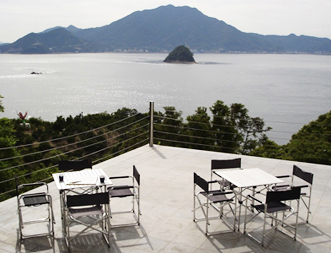 |
|
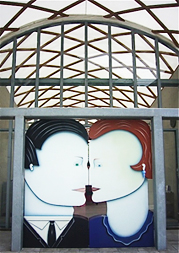 |
| The Tokoro Museum terrace overlooking the Seto Inland Sea. Photo courtesy of the Tokoro Museum. |
|
Entrance to the Tokoro Museum, with "Kissing Doors" by Noe Katz, 2003. |
The Seto Inland Sea figures largely in Japanese history, not least as the domain of the pirates prominently featured in NHK-TV's current serial epic about 12th-century warlord Taira no Kiyomori. In the more recent past, inhabitants of these shores did a thriving business harvesting salt. The latest economic trend in the Seto region seems to be the occupation of entire islands by massive contemporary art projects, the most visible of these being the clusters of Benesse-funded museums and outdoor sculpture gardens on the islands of Naoshima, Teshima and Inujima.
Practically under the cultural radar is another island further to the west that boasts no fewer than six museums -- none of them beneficiaries, alas, of the Benesse promotion juggernaut. Located midway between Onomichi on the Honshu side and Imabari in Shikoku, Omishima is one of the Seto's larger islands, but mountainous and sparsely populated. It enjoys historical cachet as the home of the ancient Oyamazumi Shrine, which ranks with the more famous Izumo and Ise shrines as one of Japan's most revered places of worship since time immemorial. Oyamazumi was where the warlords and pirates of the region prayed for success in their forays. Today its precincts are home to a number of 3,000-year-old camphor trees, the oldest in the country. The shrine's museum boasts the nation's most extensive collection of medieval weapons and armor, gifts presented to the resident deity (a brother of Amaterasu, the Sun Goddess) in gratitude for victories in battle.
Across the street from the shrine is the Omishima Museum of Art, which features an attractive collection of contemporary Nihonga. Opened in 1986, it was the brainchild of the local mayor and paved the way for more museums to come. Koji Hasegawa, a Tokyo gallery owner instrumental in the museum's development, was taken with the beauty of the island and recommended it to Atsuo Tokoro, a wealthy entrepreneur and art collector from Yokohama, when Tokoro asked for advice on where to build a museum to house his collection of contemporary sculpture. Standing atop a cliff at the southwestern corner of Omishima, Tokoro gazed over a glorious vista of boats plying tranquil waters between myriad islets and knew this was the place. Designed by Hideaki Yamamoto and opened in 2004, the Tokoro Museum is a small but imaginatively designed edifice that houses a delightfully diverse collection of recent work by Japanese and European sculptors -- and the views are to die for.
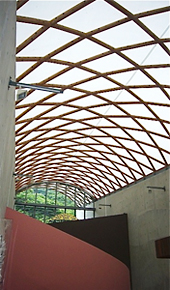 |
|
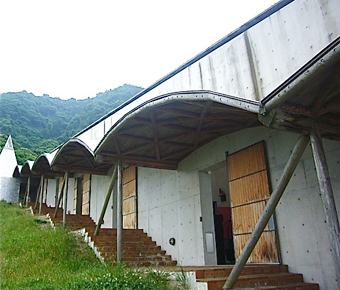 |
| Interior of the Tokoro Museum with its translucent domed roof and cedar lattice overhead, designed by Hideaki Yamamoto. |
|
Exterior of the Tokoro Museum, slanting down the hillside like a climbing kiln. |
Externally the building is not much to look at. Consisting of two parallel concrete walls that slope down the mountainside, it resembles a culvert on the verge of sliding the rest of the way into the sea. The roof spanning the two walls, however, is a thing of beauty: a gentle arch of translucent white sheeting crisscrossed by a lattice of curved cedar slats that looks like a Bucky Fuller dome designed by traditional Japanese carpenters.
One enters this tubular space through Noe Katz's "Kissing Doors" at the top of the slope. Inside, the galleries cascade downhill in a series of steps, somewhat like a
noborigama climbing kiln. Natural light shining softly through the lattice above creates an inviting ambience below, perfect for a contemplative stroll among Tokoro's tasteful assemblage of sculptures by Katz, Marisol, Giacomo Manzu, Norichika Hayashi, and Munehiro Ikeda among others. At the bottom the gallery space opens onto a broad veranda where one can sit, sip coffee, and enjoy the stunning views that so enamored Tokoro of the place.
Upon completion of the museum, Tokoro donated it to the town of Omishima in memory of his wife, who had died while construction was underway. Tokoro was also in possession of a piece of equally gorgeous cliffside property adjacent to his museum. When he expressed interest in building an annex there, Hasegawa introduced him to the noted contemporary architect Toyo Ito. In the course of their conversations, Ito shared his vision of building an architectural museum where young people could attend workshops and learn about the profession first-hand. Tokoro liked the idea, and so yet another cultural facility was born on the island -- the Toyo Ito Museum of Architecture (TIMA), which opened last year.
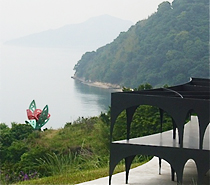 |
|
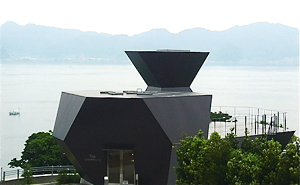 |
| In the foreground, a steel sculpture of an architectural model by Toyo Ito; downhill in the background, "Scribbled Tulip" (2004) by Tom Wesselman, part of the Tokoro Museum collection. |
|
Exterior of the Steel Hut, Toyo Ito Museum of Architecture, designed by Toyo Ito, completed in 2011. |
Touted as Japan's "first architectural museum," the TIMA might be more accurately described as Japan's first museum by and about an individual architect. Ito's maverick work is certainly deserving of presentation to the public at large, and the architect is no megalomaniac: though the museum he designed is devoted to his work, it is surprisingly -- in fact, disappointingly -- modest in scale, as are the exhibits within.
TIMA consists of two buildings. The main structure, the Steel Hut, is a small fortress of black steel polyhedrons that juts above the promontory like a cubist battleship. The resemblance to a boat is intentional -- the museum's inaugural exhibit was titled (in English) "A See-Worthy Vessel." Inside, models of buildings designed by Ito sit upon white "islands" scattered across the ultramarine walls of the main gallery space. Unfortunately, modesty may have precluded the expansion of the Hut to larger dimensions that would have more effectively showcased its dramatic design.
It is also a pity that the imaginative "islands in the sea" layout of the exhibits inside does little to inspire the viewer. The models are tiny and lacking in context (other than the quotes about architecture by various luminaries that adorn the walls), and the display feels cramped in the confines of the low-ceilinged, windowless galleries.
Downstairs, however, is a brighter atrium-like space that thrusts upward like a ship's smokestack, tapering to a triangular skylight high above. This gallery contains "Home for All," a continuing exhibition about a project initiated by Ito and his colleagues to design community gathering spaces for residents of the temporary housing complexes that have sprung up throughout the tsunami-devastated Tohoku region. With large windows looking out on the sea (and framing views of some whimsical outdoor sculptures perched on the cliffs below), and walls covered with a happy hodgepodge of colorful sketches, the room has the cheery vibe of a giant treehouse. To their credit, the architects encouraged submissions from schoolchildren as well as adults -- and to this curmudgeon's eye the kids' designs looked a lot more fun, and practical, than many of the professionals' proposals.
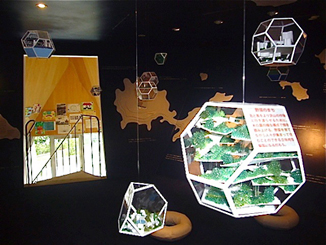 |
|
 |
| Polyhedral mobiles containing miniature architectural environments by Toyo Ito hang in the main gallery of TIMA. In the background are "islands" on the wall with models of works by Ito, and stairs leading to the downstairs gallery. |
|
The downstairs gallery at TIMA, with a triangular skylight high above and drawings submitted for the "Home for All" project on the walls. |
Adjacent to the hulking Steel Hut is a second, very different building, the Silver Hut, actually a reconstruction of Ito's former residence in Nakano, Tokyo. Serving as a workshop and study space, the Silver Hut is a row of simple prefab-like units with arched galvanized-steel roofs that resonate nicely with the shape of the Tokoro Museum down the road. In contrast to the Steel Hut, this structure is light, airy, and welcoming, with a broad porch overlooking the sea. In a setting as sublime as this one, perhaps it's inevitable that even the most cutting-edge designs take a back seat to the architecture of nature at its grandest.
In addition to TIMA, the Tokoro Museum, the Omishima Museum of Art, and the Oyamazumi Shrine Museum, the island is home to the Ken Iwata Mother and Child Museum, designed by Ito and featuring outdoor sculptures, and the Murakami Santo Memorial Hall, a calligraphy museum.
A few years ago the town of Omishima was absorbed into the Shikoku city of Imabari, which now runs both the Tokoro Museum and TIMA. As all too often happens with more outlying municipalities in such mergers, Omishima and its museums do not appear to be high on Imabari's list of priorities when it comes to tourism campaigns or transportation infrastructure. That's a shame, because the traveller who makes the effort required to get to the island is rewarded with a trifecta of cultural, historical, and scenic pleasures unmatched anywhere in the Japanese archipelago.
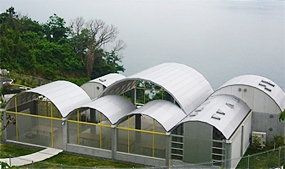 |
|
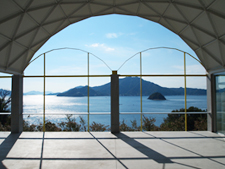 |
| Exterior of the Silver Hut, originally built in Tokyo as Ito's home in 1984. |
|
View of the Seto Inland Sea from the deck of the Silver Hut. Photo courtesy of TIMA.
All photos by Alan Gleason unless otherwise indicated. All images by permission of the Tokoro Museum, the Toyo Ito Museum of Architecture, and the City of Imabari. |